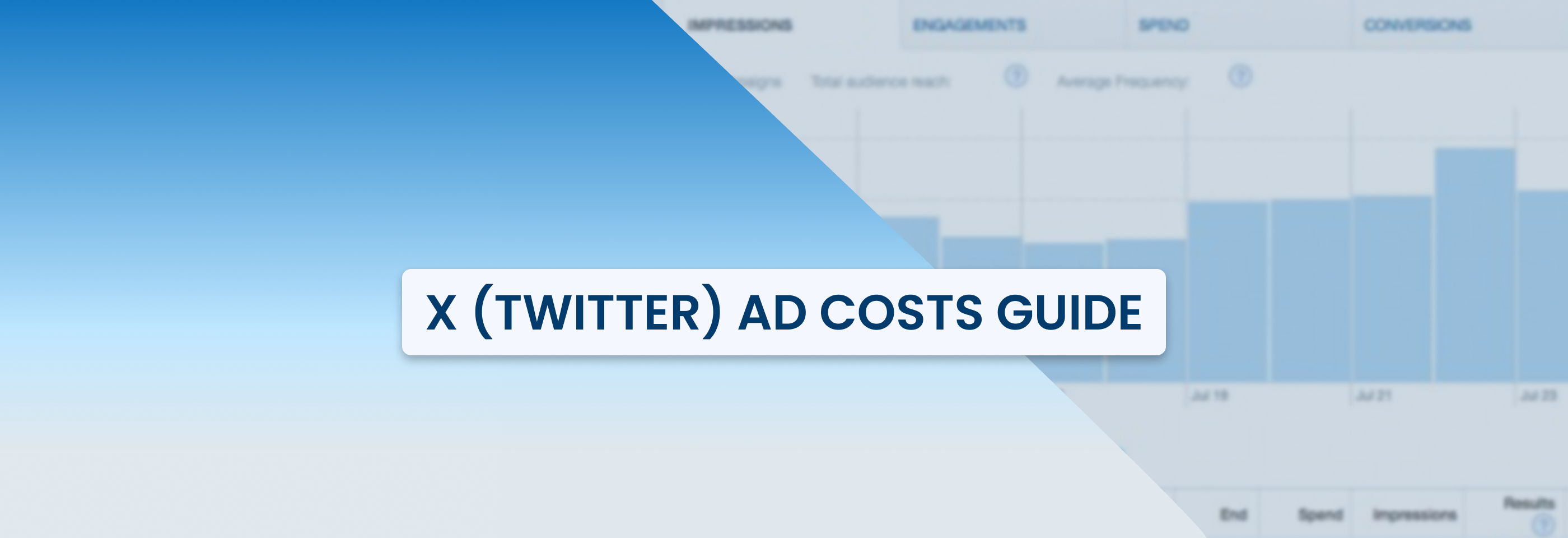How To Reduce Facebook Ad Costs With Ad Automation
2024-10-08
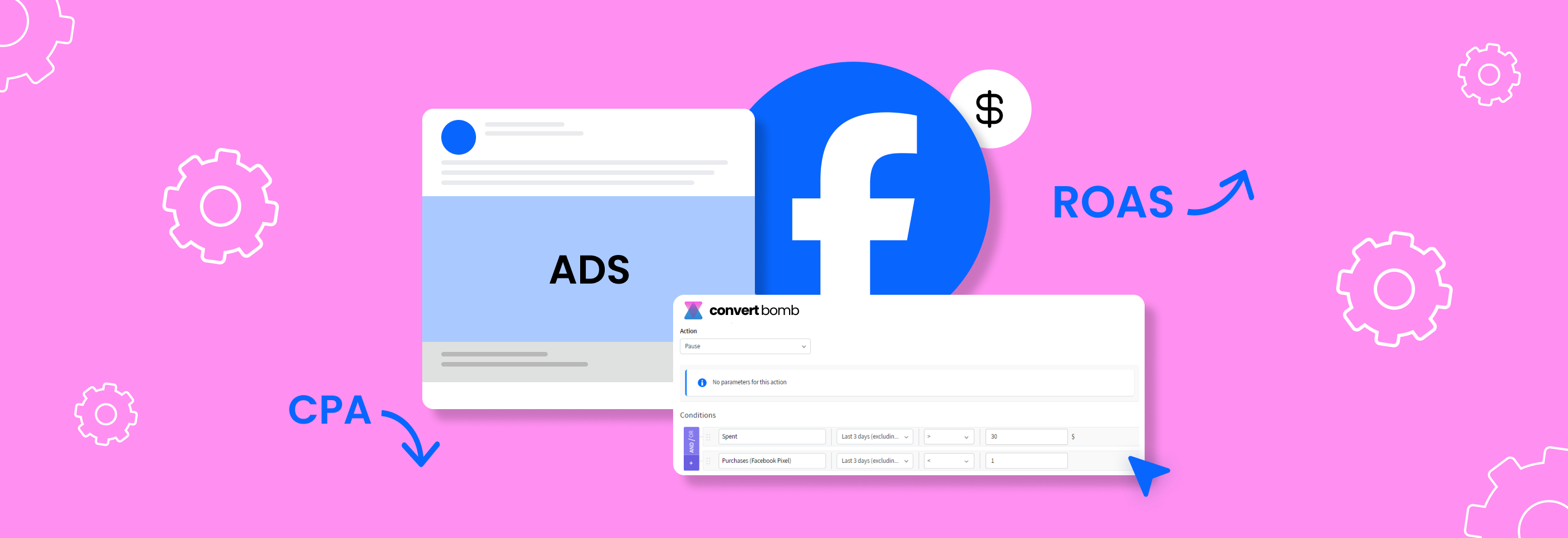
Struggling with high Facebook ad costs?
You’re not alone: many advertisers face rising Facebook and Meta ad costs, especially in Q4 when competition is more intense.
Holiday promotions, sales, and increased demand for ad placements drive costs higher. For businesses with smaller ad budgets, this can be a real challenge, leading to higher cost per click (CPC), cost per conversion, or cost per lead.
That’s why managing your Facebook ad spend is key, especially when you're working with limited funds. Every dollar counts, and working to spend your ad budget more efficiently is crucial if you want to reach your target ROAS or CPA.
Luckily, this problem can be solved with Facebook ad automation: you can reduce your advertising costs while improving performance. By automating certain parts of your campaign, you save time and money while boosting your results.
We’ve already talked about how to optimize ad budget with automated rules. In this guide, we’ll show you how to simplify this process even more with the help of automation strategies.
How can Facebook ad automation help you lower ad costs?
To put it simply, ad automation helps you adjust your ads based on their performance, budget, or timing. If you’re trying to lower your Facebook ad costs, this can be a game changer.
For example, you can maintain a specific average daily budget for your ads, increase or decrease spending based on results, stop poorly performing ads, and do other tasks that help you spend no more than you can afford.
You can also automate changes to reduce your cost per lead, cost per click, or any other costs you’re tracking. For example, if your ads are performing well and staying under a set CPA (cost per action), you can automatically boost spending on those ads. If the CPA goes too high, you can pause or lower its budget automatically as well.
This is especially useful when working with a minimum Facebook ad budget – you can prevent overspending while still maximizing ad impact.
Now, let’s see how to do all this and more with ConvertBomb.
Top Facebook ad automation strategies to reduce ad costs
If you’ve read our article about our Facebook ad automation strategies, you already know how they work on ConvertBomb.
If you haven’t, here’s a little recap:
Ad automation strategies are essentially pre-made templates of several Facebook automated rules designed to optimize your ad campaigns in specific ways. These rules have conditions and triggers tailored to specific optimization goals, and when those conditions are met, the system performs the actions you choose automatically.
These strategies are a great option if you haven’t automated your Facebook ads before, or if you simply want to find the right automation algorithm fast. The best part about these strategies is that while they come with standard settings, you can customize them to suit your needs: you can choose which metrics to focus on, adjust metric thresholds, and decide when rules should apply.
There are three main types of ad automation strategies on ConvertBomb: general, ROAS-based, and CPA-based. For the sake of convenience, they are grouped based on their use cases (E-commerce, Lead Generation, and Mobile App) and the tasks they perform (Scale, Pause, Optimise, etc.).
In this guide, we’ll mainly focus on ROAS and CPA-based strategies created to help E-commerce businesses manage their Facebook ad budget better and reduce their advertising costs. Keep in mind that you can always adjust the metrics in these strategies to fit your specific goals.
Without further ado, let’s review the top Facebook ad automation strategies you can use for reducing your advertising costs not just on Facebook itself, but also across all Meta platforms.
ROAS-based strategies
Simply put, ROAS-based strategies use ROAS and other related metrics to help you spend your ad budget more efficiently and get better results from your money.
Here’s a list of Facebook ad automation strategies you can use to optimize your Facebook ad spend based on ROAS:
1. SCALE PROFITABLE CAMPAIGNS
This ROAS-based strategy helps you keep your ad budget under control and spend it more effectively by focusing on ads that are making the most profit.
It uses four metrics:
- Daily budget – your maximum spend per day on ad set;
- Spent – the total amount of money you've used up during a specific timeframe;
- Purchases – the number of sales driven by your ads (this metric is measured through Facebook Pixel installed on your website);
- Purchase ROAS – the amount you’ve earned from sales compared to your ad spend.
This strategy works through these 4 rules:
Rule 1: Boost budget for winners
The first rule of this strategy helps you increase budget by $50 once a day if there were more than 3 purchases on your website in the past 3 days and the ROAS was greater than 3. You can change the timeframes and how much you want to increase your budget for depending on your campaign’s details.
Basically, this rule is all about helping you scale the most successful ads by investing more money in them.
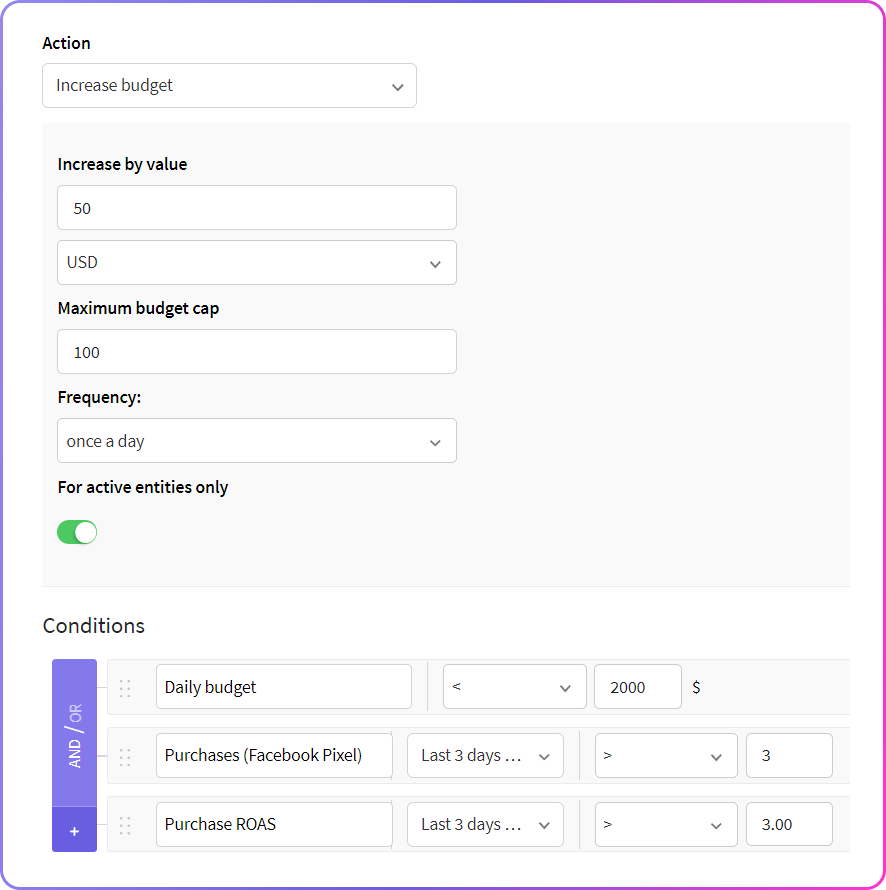
This rule also takes into account your daily budget: you can make sure that the budget will be increased only for ad sets or campaigns that haven’t exceeded your maximum daily budget. If you want to be on the safer side, you can set the maximum budget cap as well: this way, you won’t spend more than you want.
Rule 2: Pause low performers
The main goal of this rule is to help you stop wasting money on ads that don’t deliver. It will automatically pause ad sets that didn’t have enough sales and spent more than $30 within the last 3 days.
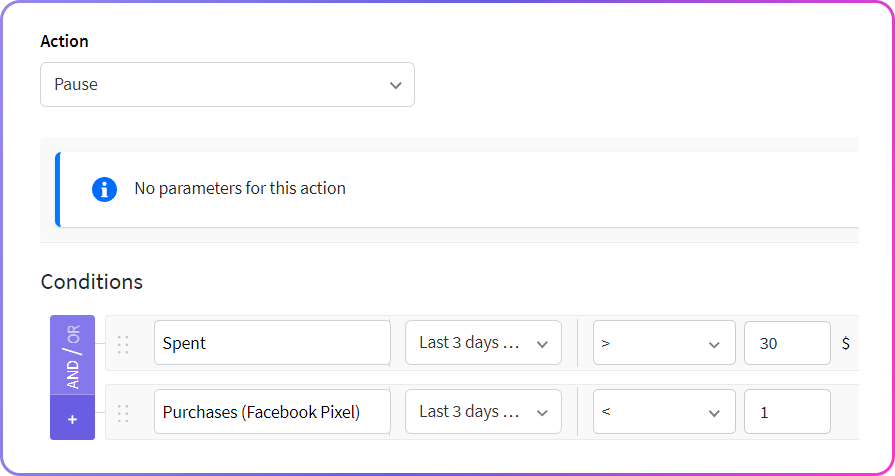
This pausing rule is essential to prevent budget loss because of the low-converting ad sets. However, even if certain ad sets don’t end up in this category, it doesn’t mean that they perform well enough to keep them running.
That’s why we have the next rule in this strategy.
Rule 3: Reassess underachievers
This rule allows you to evaluate ad sets that are technically generating sales, but aren’t profitable enough because they have a low ROAS. Pausing ad sets like this helps you maintain a desirable ROAS level and leave more of your ad budget to pour it into more effective ads.
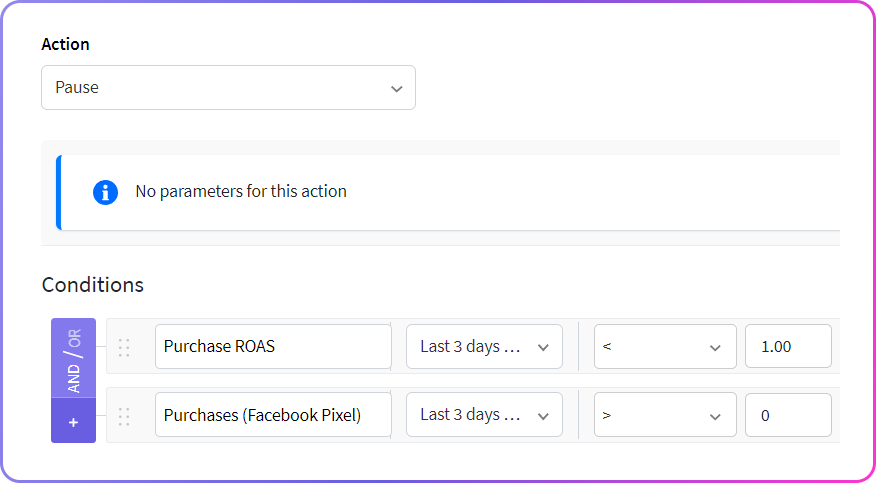
But here’s another caveat: there’s such a thing as late conversions – your ad sets can generate sales even after they’ve already been paused.
For example, late conversions happen when someone sees your ad, doesn't buy anything right away, but then decides to make a purchase days or even weeks later. Basically, it's when your ads eventually lead to sales, just not immediately.
In this case, you might want to start running them again to see how they’ll perform. Luckily, we have our Rule №4 to handle this automatically.
Rule 4: Restart potentially profitable ad sets
The final rule of this strategy restarts paused ad sets that might become profitable. In this example, it will happen if the ad set’s ROAS goes higher than 3 during a specific timeframe. You can make it longer to make sure that all late conversions are being properly tracked and attributed.
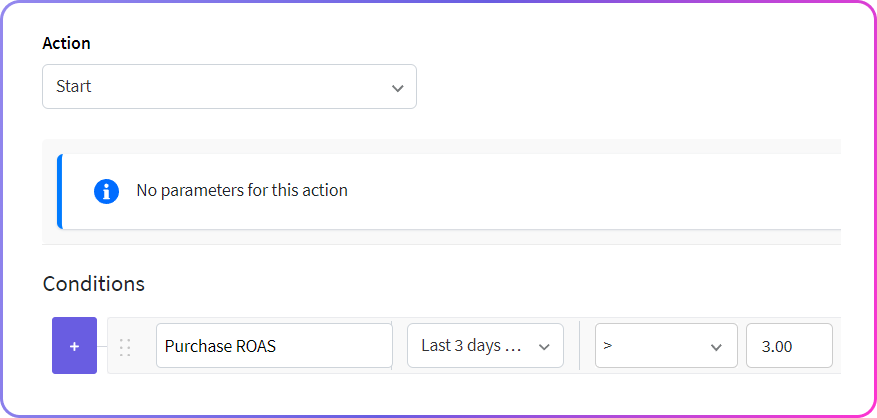
This rule prevents you from overlooking ad sets that don’t perform well at first glance, but end up generating conversions.
To sum up, this Facebook ad automation strategy allows you to maintain a high Return on Ad Spend (ROAS) by focusing your ad spend on high-converting ad sets, pausing low-performers, and restarting ad sets with late conversions.
2. RAISE THE STAKES
This ROAS-based ad automation strategy helps you duplicate a high-performing campaign and scale its budget.
It uses three metrics or triggers:
- Website Purchase ROAS – this is what you’ve earned from sales on your website compared to what you’ve spent on ads;
- Hours since creation – how long the campaign has been running;
- Campaign name – in this strategy, this will mean all campaigns with a #duplicate tag in their name.
There are 2 rules in this strategy:
Rule 1: Duplicate winning campaigns
This rule allows you to replicate the success of your best campaigns. If a campaign had ROAS above 3 today, it will be duplicated.
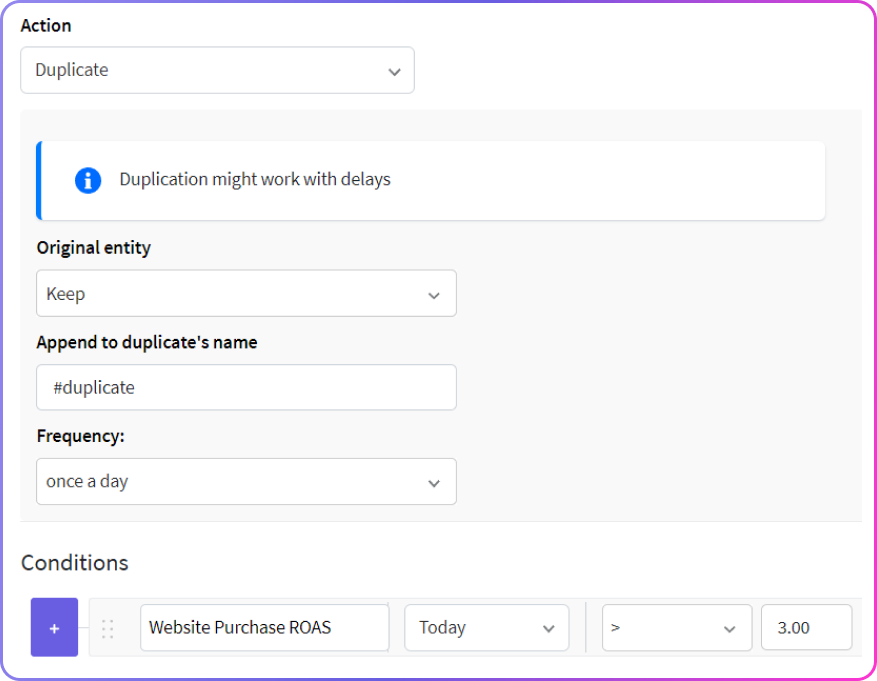
In the standard version of this rule, it will happen only once a day – the frequency of the rule action matches the timeframe in the condition, which allows us to avoid duplicating the campaign too often. This rule will also add a #duplicate tag to the campaign name, making it easier to find it among all other campaigns you’re running.
Rule 2: Raise budget for duplicate campaigns
The second rule will raise the budget of the duplicated campaigns by 100%, i.e. by two times. This helps you scale campaigns that are already proven to be successful to maximize their potential.
The hours since creation < 1 part of the condition makes sure that you scale only the recently duplicated campaigns. You can change this timeframe based on your case, or skip this condition altogether if you want to scale all duplicated campaigns no matter when they were created.
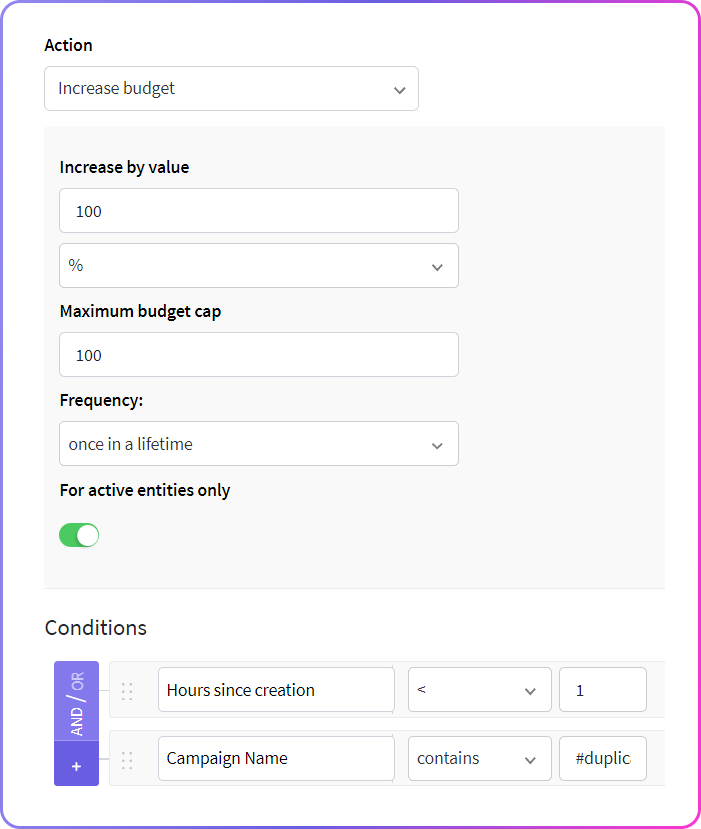
This strategy helps you automatically duplicate and scale successful Facebook or Instagram ad campaigns, so you can reach a larger audience without the trial and error of creating new ads.
After all, if a campaign already performs well, why not try running it for a new audience or on a new ad placement with a higher budget? This way, you're investing in what works well and potentially reducing wasted ad spend.
3. STOP THE FAILURE
This ad automation strategy helps you pause ad sets that don’t generate conversions even when you spend a lot on them.
Here are the main metrics used in this strategy:
- 2 x Spent / Daily budget – basically, it means the number you get after dividing twice the amount a particular ad set spent by the campaign’s daily budget. This relation helps you check how much each ad set is spending in proportion to the overall daily budget of the campaign it belongs to;
- Purchase ROAS – this is what you’ve earned from sales compared to how much you’ve spent on the ad set.
The strategy has just one rule:
Rule 1: Pause unprofitable but expensive ad sets
This rule stops ad sets that already spent more than a half of the campaign’s daily budget today, but had a low ROAS. Essentially, you’ll be pausing ad sets that spend more than what they generate in return.
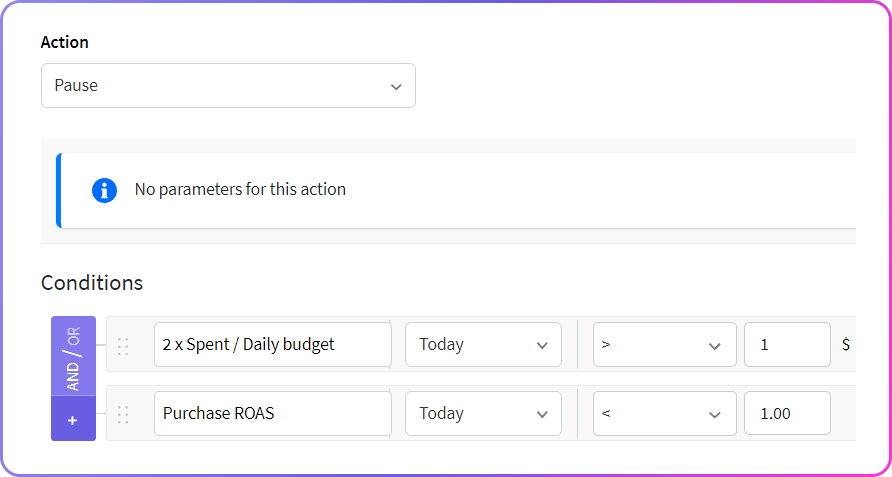
With this strategy, you can save money that would be wasted otherwise. Once you stop these unprofitable ad sets, Facebook will have more budget to spend on others that perform better and achieve a good ROAS.
4. TOP THREE (ROAS)
This strategy helps you keep only the three highest-ROAS ad sets active every day, pausing all the rest.
It uses two metrics:
- Time – in this case, it will be “less than” a specific hour;
- Website Purchase ROAS – what you’ve earned from sales on your website compared to what you’ve spent on ads.
There are two rules in this strategy:
Rule 1: Pause ad sets at a specific time
This rule will pause all ad sets in a specific campaign at a specific time. In this example, this will happen when the time is less than 1 a.m. every day throughout the whole week.
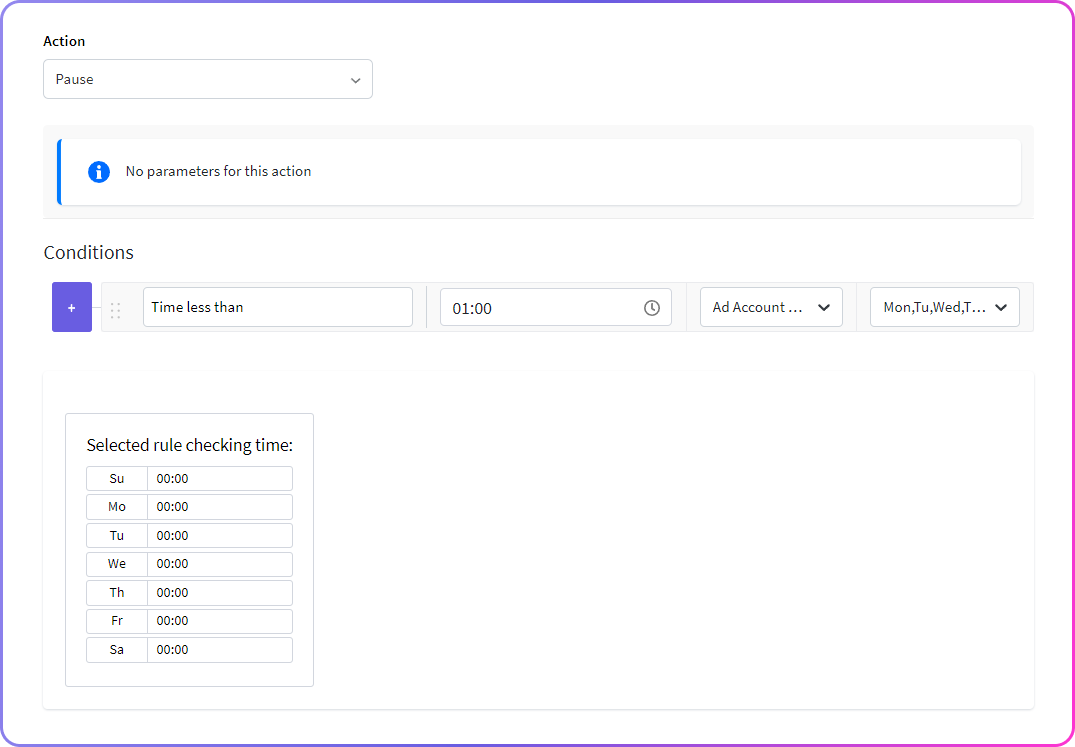
Keep in mind that you need to select the right rule checking time for this type of rule – it should be logically consistent. We’ve set the time at 12 a.m., which means that this is when the rule’s condition will be checked. At 12 a.m., the rule’s condition will be true, and the rule’s action will be performed – the ad sets will be paused.
You can change time in both the condition and the rule checking schedule as you want. For example, if you know that people aren’t likely to see your ads during specific hours of the day, it might be a good idea to pause and restart them later.
But our main goal is to not just pause ad sets: we want to keep running only the most profitable ones. That’s why we need the second rule.
Rule 2: Restart high-ROAS ad sets
This rule will restart top 3 performing ad sets based on their ROAS. Only three ad sets that had the highest Purchase ROAS during the last 3 days will be running until midnight (when the previous rule gets triggered again).
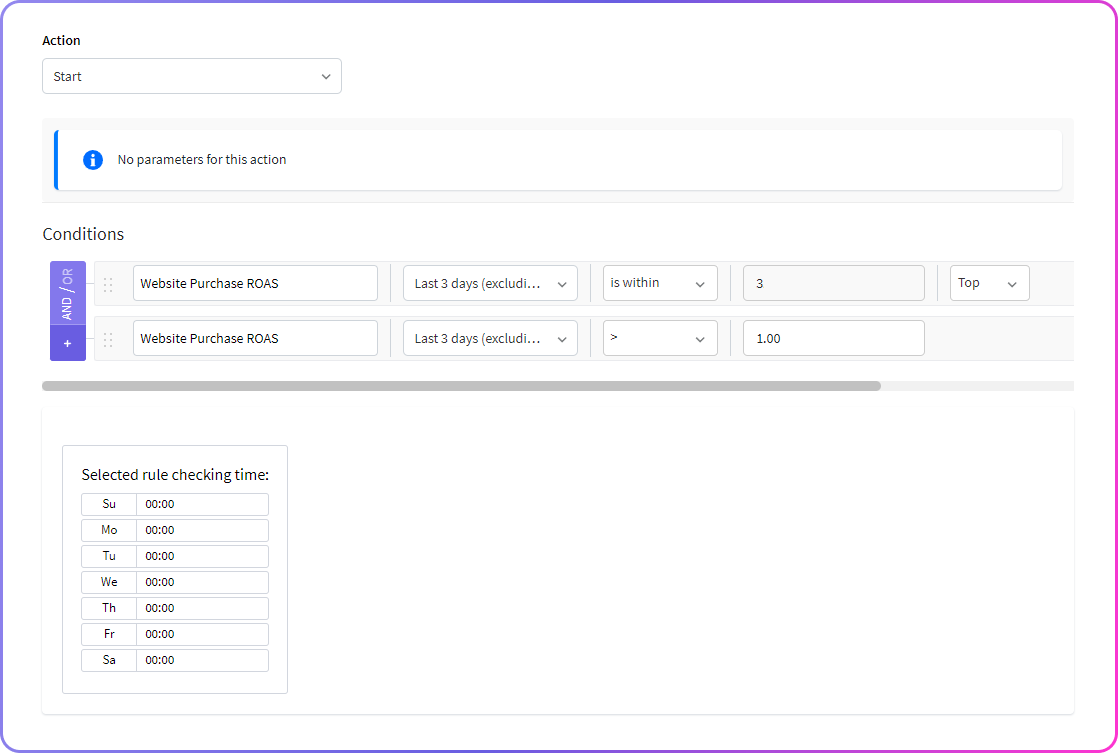
Here, we have two conditions. One condition helps us to select profitable ad sets with ROAS higher than 1, and the other allows us to go further and choose three ad sets that performed the best out of all of them.
Next, we have our CPA-based ad automation strategies that can help you reduce your ad costs by focusing your efforts on campaigns and ad sets with the lowest CPA.
CPA-based strategies
1. SCALE THE TOP HALF
This strategy raises the daily budget of half of the top-performing campaigns in terms of Cost Per Action (CPA). It includes two metrics:
- Cost per Purchase – the amount you spend on each purchase attributed to your Facebook ad campaign;
- Purchases – how many sales you’ve got during a specific timeframe from your ads. By scaling ad campaigns with a lower CPA, you can maximize the returns you’re getting.
Essentially, it’s all about helping you increase your ROAS: you spend more on these campaigns, but they deliver you more sales at a lower cost.
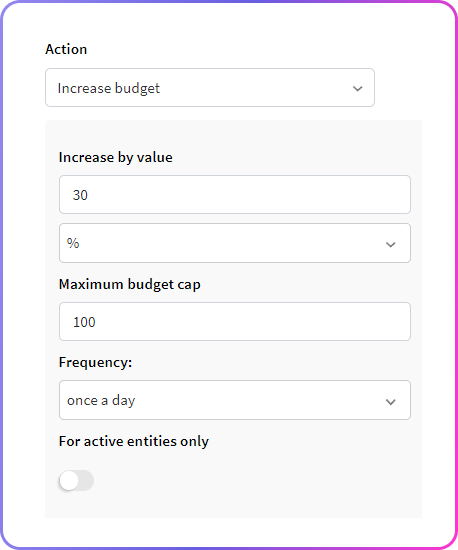
The main action of this strategy increases the budget by 30% once a day. You can change the amount based on your needs and goals, set the maximum budget cap to avoid overspending, and choose whether to apply the rule to active entities only or to all of your campaigns (this might be useful if you’re pausing them during certain times of the day).
This rule has two conditions.

The first one helps you scale only the cheapest half of your campaigns based on their Cost per Purchase within the last 3 days. The second one makes sure that those campaigns had sales during the same timeframe – you definitely don’t want to scale campaigns that cost you less simply because they aren’t converting.
Again, you change the metrics and their values as you wish to fit this strategy to your campaigns.
You can take this strategy even further by adding the second rule to the mix. For example, you can lower the budget for ad campaigns with high CPA. Your ad budget will go toward the best campaigns and you won’t be spending too much on campaigns that aren’t as cost-effective.
2. TOP THREE (CPA)
The final Facebook ad automation strategy on our list works similar to the ROAS-based “Top Three” strategy, only that it uses different metrics: Cost per Purchase and Purchases, just like in the previous CPA-based strategy.
It also has two rules:
Rule 1: Pause ad sets at a specific time
This rule will pause all ad sets at midnight.
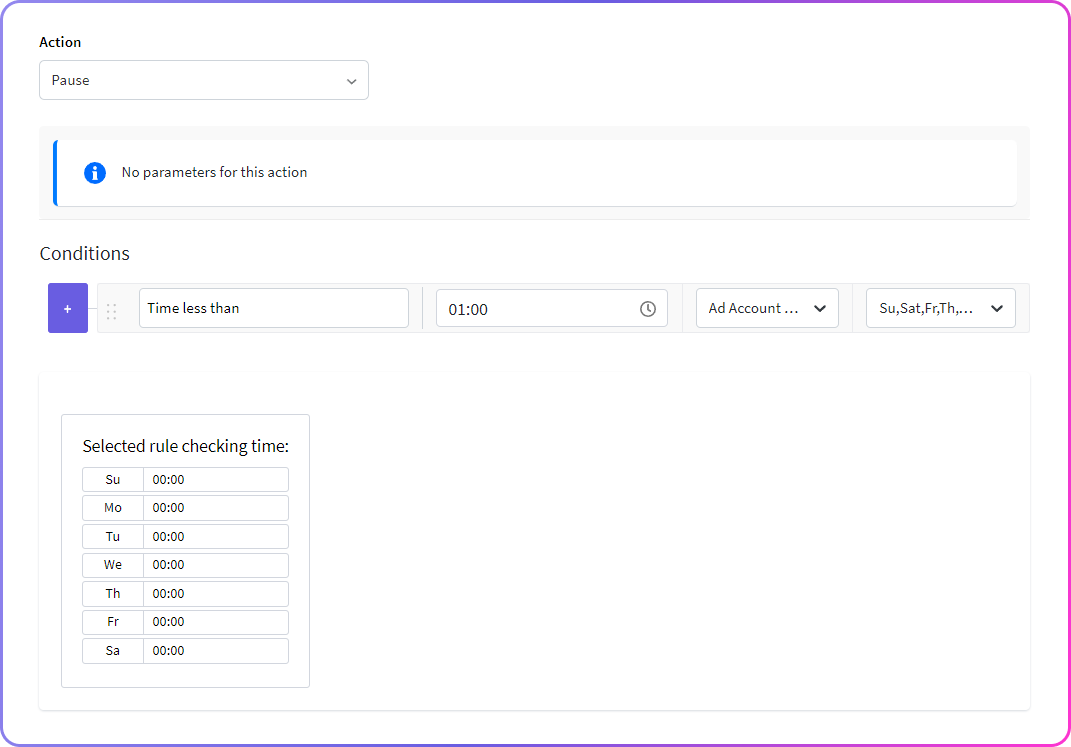
Tweak the metrics and the rule checking time here as you need to fit your campaigns.
Rule 2: Restart low-CPA ad sets
The other rule will restart the three most cost-effective ad sets during the last 3 days. As per our conditions, those three ad sets will have the lowest Cost per Purchase while being profitable.
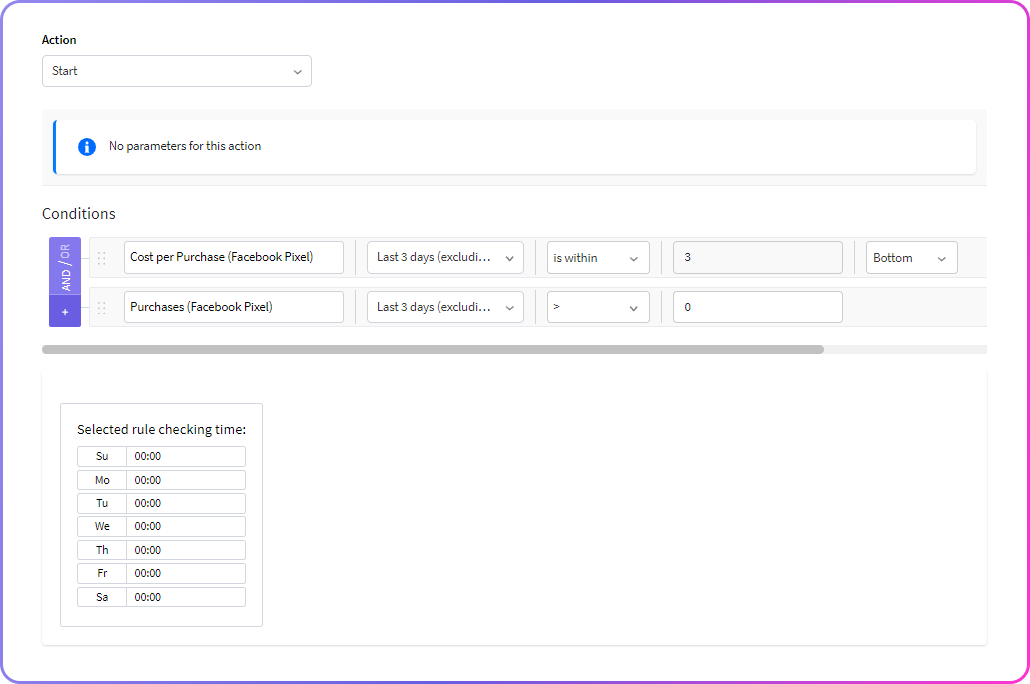
Similar to the ROAS-based strategy, this one ensures that only the best ad sets receive the budget, which helps you reduce overall advertising costs.
By focusing on the ad sets that convert best at the lowest CPA, you can optimize your spending and make your campaigns more efficient.
Recap
Using the right Facebook ad automation tools and strategies is key to saving your money and putting them where they’re needed the most.
With ConvertBomb’s ad automation strategies tailored towards specific optimization goals, you can optimize your Facebook ads and make sure they always stay profitable and cost-effective. If you’re ready to try them out and reduce your Facebook ad costs, sign up for a free trial now.

